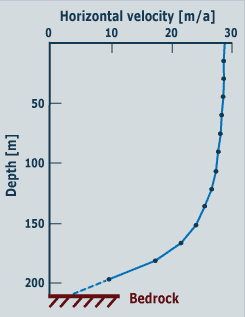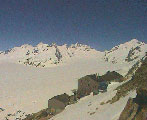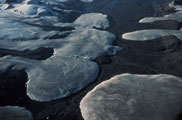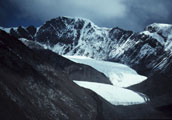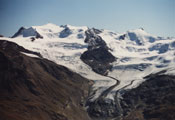 |
|
|
|
|
|
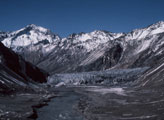 |
In addition to advancing and retreating, glaciers actually flow. The curving of crevasses and banded structures known as ogives, the recordable movement of surface rocks over a period of days, and the occasional cracking and creaking sounds within the ice are all symptoms of this. Ice flow is also indicated by the eroded rocks and deposits that are left behind after the ice margins have retreated. The nature of the ice flow, in fact, very much determines the character of a glacier. Rates of movement of flowing glaciers are extremely variable. Some small glaciers and ice caps may flow only a few metres a year, or are motionless. The fastest parts of most reasonably sized valley glaciers flow anywhere between 50 to 400 metres a year. Large ice streams in Antarctica and outlet glaciers in Greenland even flow at a rate of a thousand metres a year or more. Some glaciers flow in a rather unpredictable manner, remaining relatively inactive for many years, then accelerating suddenly. For a period of a few months they advance over distances measured in kilometres. This phenomena is called glacier surge. |
| 1 - Glacier surge, Rio Plomo, Argentina, notice the heavily crevassed surface of the glacier (120K) |
|
Ice flows by two main processes: |
|
|
Internal deformation |
|
As snow turns to firn and then ice, its constituent crystals alter under the weight of material accumulating above them and under the influence of gravity. These stresses cause the ice to change shape in a rather plastic manner, much as soft putty or porridge will deform on a slope, only considerably slower. A typical flow pattern shows an initial,
rapid increase in velocity away from the margins, then a declining
rate of increase towards the middle.
|
2 - Variation of horizontal velocity with depth, Athabasca glacier, Canada. Data from Savage and Paterson (1963) in Paterson (1994) |
Basal Sliding |
|
|
The second component of glacier flow is basal sliding, whereby the glacier slips over its bed. Large quantities of melt water produced in summer reduce the friction between a glacier and its bed and cause faster flow. In a temperate glacier, basal sliding is the major component of its flow, and may account for as much as 90% of its total movement. Where basal sliding occurs over uneven bedrock it often generates caves, where processes of erosion and deposition can be studied. Since sliding velocities are related to the amount of meltwater available, glaciers move
|
|
Exceptional speeds may also be induced by heavy rain. In cold glaciers basal sliding can only occur where the ice is thick enough for the base to be warmed to melting point. Moreover, it is quite common for the snouts of otherwise sliding glaciers to be frozen to the bed because the ice is thinner there and thus affected by the low mean annual air temperature. In addition, a layer of unconsolidated sediment known as till often underlies moving ice. This is a mixture of particles of all sizes from clay to boulders. When this material is saturated with water, this sediment deforms more easily than the basal ice, and glacier movement is assisted by shearing within the soft, deformable sediments, rather than by sliding. |
|
These
time-lapsed photographs (532K) show the increase
in the snow line from June to August. In addition, the flow
of the glacier ice can be very easily recognised, especially from
the high ice velocities in the ice fall from the perennial snow field
(Ewigschneefeld, upper right side of the picture). |
3 - A time-lapse webcam photo of the Konkordiahuette at 2850m (532K) |
|
|
|
The temperature distribution in glaciers and ice sheets
deserves added attention because of its influence on different processes.
The present variation of temperature with depth provides information about
past variations of surface temperature. The
deformation rate of ice is very sensitive to
temperature; cooling from –10°C to –25°C reduces this
rate by a factor of five. If the temperature of a glacier, previously
frozen to the ground, were to reach the melting point
at ground level, the ice could start to slide and lead to unstable behaviour
of the glacier. The basal temperature also controls erosion; the bed is
protected if the ice is frozen to it. Properties such as the velocity
of seismic waves, the absorbtion of radio waves and the DC
resistivity, on which methods of measuring ice thickness depend, also
vary with temperature. The distribution of temperature in the ice is mainly
controlled by the surface temperature and therefore
by the energy balance. In addition,
if the ice slides, geothermal heat and friction warm or melt the base
while ice deformation and in some cases refreezing of meltwater warm the
interior. Conduction,
ice movement, and in some cases water flow transfer heat within the glacier. |
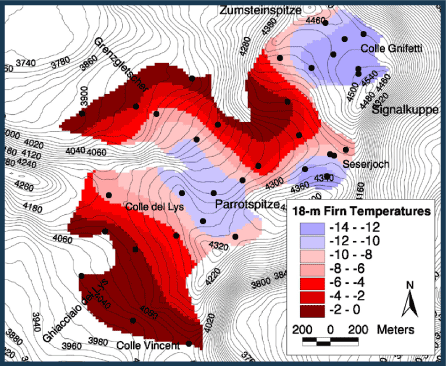 |
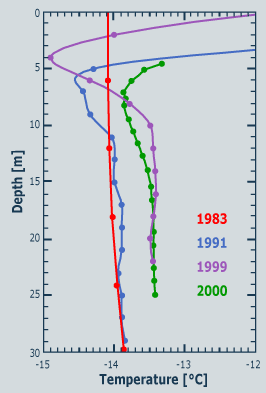 |
|
7 - Temperatures measured at 18m in the Monte Rosa area showing grid-interpolated
values. Black points represent the borehole locations. |
8 - Temperatures measured
englacial at Colle Gnifetti, Monte Rosa area from 1983 to 2000 showing conditions
for 1983, 1991, 1999, 2000. Source: Suter (2002) |
29 August 2011 |
||
| |
||
